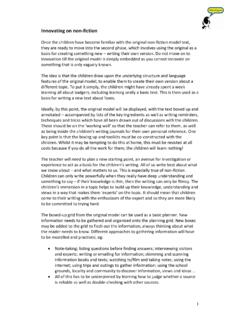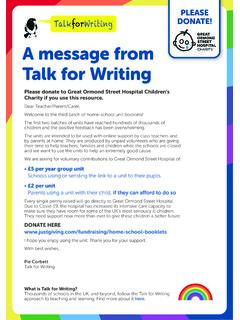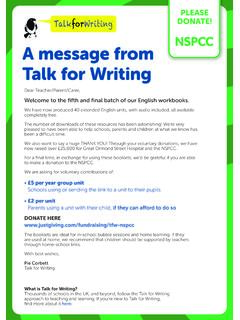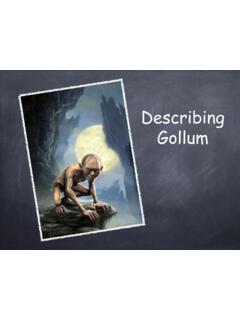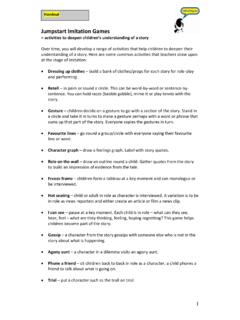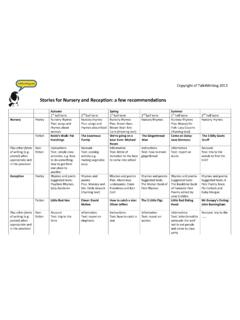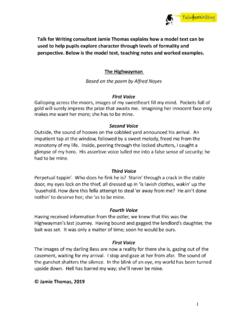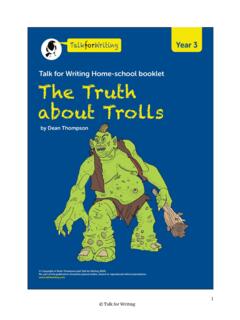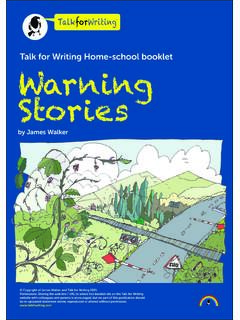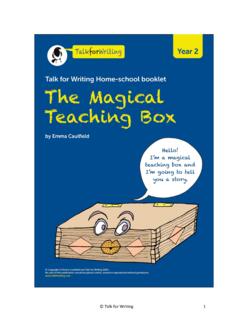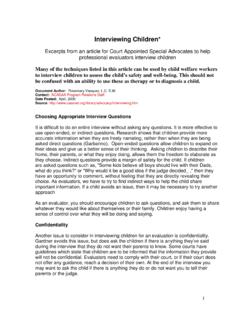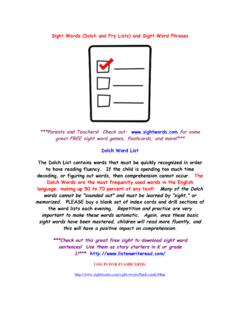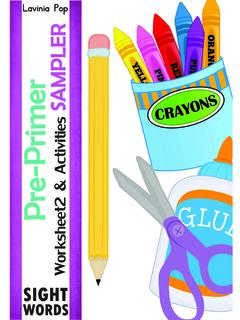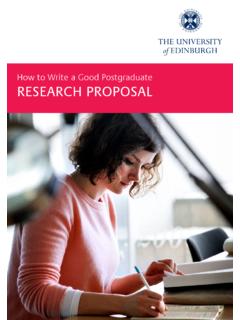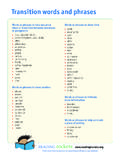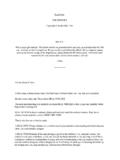Transcription of Writing and text mapping your own model text
1 Writing and text mapping your own model text Talk for Writing consultant Kathryn Pennington explains how and why she writes and maps her own model text. In the first half of this article, which you can read here, I explained how there are three approaches to consider when sourcing a model text: using a novel or a picture book as a stimulus; rewriting an original story and Writing your own model text from scratch. Previously, I focused on the first two of these and in this half of the article I thought I d share what has worked for me when Writing my own model text. First, let s recap two frequently-asked questions on model texts . 1. Why do you need a model text at all? Having a model text is vitally important in the Writing process. Without showing children a model of what is expected, it is a little bit like saying to them, Today I am going to teach you how to play tennis. However, I am not actually going to show you what playing tennis looks like.
2 You need a clear example of what good looks like and that s where the model text comes in. 2. What should a model text look like? A good model text should clearly exemplify the key features that the children need to learn in order to make progress. It should include the areas for development identified from the cold task that helps you to know what the children can already do. It should be short no more than 350 words in length and memorable because the children are going to internalise the text by learning it off-by-heart. A good model text should have a clearly identifiable, transferable plot pattern on which children can base their own Writing . The aim is to pitch your model text high but not too high so that it is aspirational but achievable. Make sure that you re clear about what your pupils will learn from the model . It is the key resource for your unit as the model text exemplifies the learning at the heart of unit so it is important that it is right.
3 How and why I write a model text Writing your own model ensures that it will cover exactly the features that the children need to focus on. When I write a model , I always start with two things: the boxing-up planner from Creating Storyteller and Writers plus ideas from real life or from my reading. I collect story ideas all the time, whether it be the lonely scarecrow in my garden covered in snow or a strange tower in our local park. I write them all down and use them to help me write my model texts . I start by planning my story doing a boxed-up plan to give me a rough idea of where I want the story to go. I know that some writers can just start Writing from an initial idea and see where their story takes them but I have always needed to know my ending before I start. Anthony Horowitz, speaking on Radio 2, offers some good advice regarding Writing short story Writing which you can hear on Whether the boxing up comes first or the ideas do, it doesn't really matter but once I have both, then I m off.
4 When I start boxing up the different parts of the story, I think of the story type, for example a warning tale, as this gets me off to a good start getting a good model with a clear, transferable pattern is the most important thing. My next step is to write it. I write from the heart and my instinct first. I write for enjoyment rather than constantly thinking about whether I am including everything from my target sheet. Once I have written my story and am happy with it, I look closely at it to ensure that the writer s toolkit, which I want the children to learn to use, is clearly exemplified and effectively used. For example, if I want to teach the children how to write suspense, then I need a good example of where suspense is developed within my model . Similarly, if I want to teach the children how to write a fabulous setting, I need to examine my model to check that it clearly demonstrates to the children how to write effective settings so it can be the source of the Writing tools they will need to choose from.
5 Creating Storytellers and Writers is a fantastic book to help with this. It includes all the toolkits that children need to be able to write the key ingredients of good stories: openings and endings, suspense, characterisation, settings, dialogue and description. These are presented as handy grids (as illustrated here) that you co-construct with the children year on year to build up their skills. These are excellent to help guide you so you know what features to include in your model text. These are the features that you will then use to help the children construct the toolkits that they need to write effectively and they are the features you will demonstrate in action through shared Writing . One thing that really helps me with Writing my model texts is the fact that I read a lot of children s literature. Being a reader helps me to magpie ideas, words , phrases and structures from others. When you read children s books and come across a great example of setting, characterisation or action, pop a Post-it note in the book or make a note of it so that you can always come back and refer to it.
6 If you don t read a lot of children s literature (and it will be hard for you to be an effective teacher of English if you don t), I would strongly suggest you try at least one or two books from Pie s Reading Spine. This will greatly help you to write your own. If you need motivation, it s worth looking at research such as Teachers as readers which shows the importance of having a teacher that reads. Annotate your model Once you ve finished your model text, annotate it, highlighting all of the aspects that you will be focusing on: the clearly identifiable underlying pattern the grammar of the sentence structures and related punctuation any new vocabulary the writerly tools you are exemplifying. This is a good way of testing your model . If all of these aspects are not clear, tweak your model so they are. We all need help to write a good model . Some schools share their model texts at staff meetings to ensure accurate pitch and progression.
7 My colleague Jo Pearce has written an article including a model text with teaching notes highlighting the key features. It might be useful to look at Jo s example here before Writing your own so that you can see how she pulls out the features that she wants to focus on. Text mapping Once your model is written, you will need to text map it. I m often asked by teachers if they should map in front of children or prepare the map in advance. Recently, Pie responded to the same question: Do you draw it in front of the children ? Yes, especially in EYFS, Year 1 and into Year 2. If you teach in KS1 in a school where they have already had several years of Talk for Writing , you might be tempted to miss it out and do one at home. However, it should be such a rapid process that it only takes a short while. Work it out beforehand and be very swift just using stick men. The purpose of the map is to aid visual memory so the children can see the plot.
8 It is also useful because the process of turning the words into graphic representations aids memory there is considerable research into the links between drawing ideas and memorisation. It means that the learning of a model text orally is simpler because they hear it, say it, draw it, see it, move to it and perform it therefore, almost every child can learn it which, in the long run, will mean every child can read it. I would not draw lovely maps. This gives children the idea that they can only do this if they themselves can draw. It is not art, it is a simple memory jogger. Do not use downloaded images as that will also weaken the memorising and undermine children 's confidence. When drawing your map, get a flip chart and angle it so that you can sketch at the same time as looking at the class. Don t take lots of time over it do it fairly quickly. Finally, do not draw the map whilst reading the text.
9 The teacher presents the text orally and draws it from their oral retelling. The teacher needs to learn the text first themselves. If you, the teacher, don't know the model text off by heart then you are in for a long haul as you re trying to teach the children something that you yourself do not know. It is essential that you know the oral text well then it is easy to teach. Why write the model yourself Writing a model text yourself is rewarding as it means not only can you pitch it at the right level, but also choose a topic your class is interested in and include all of the key features that you want to focus on. Make your model texts aspirational but achievable and remember, once you ve done one you will always have it to use year on year just tweak it to meet the needs of your new class. Kathryn is an accredited Talk for Writing trainer that offers training throughout the UK. Kathryn was a former Assistant Head of a large primary school in Northamptonshire, where she successfully led the Talk for Writing approach and worked as a Lead Literacy Teacher, Advanced Skills Teacher and a Specialist Leader of Education.
10 For more information and to book training: Web: Email.
